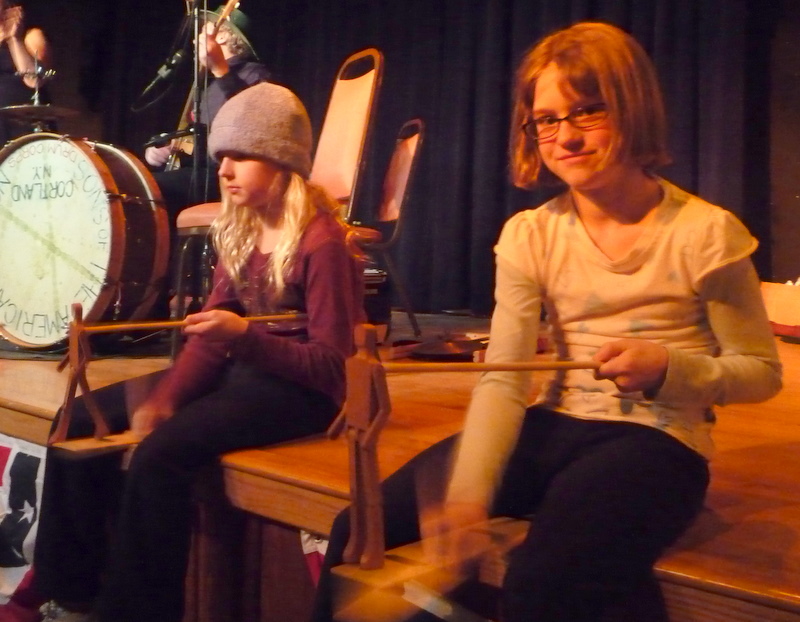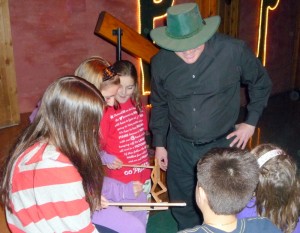How To Play The…
Hand Saws weren’t only used for logging on the Oregon Trail–at night they made music. A Pioneer woman could beat her clothes against a washboard– but when the laundry was done, she could beat time on that very same washboard. George Washington’s soldiers jigged around the campfire to the lilting voices of homemade penny whistles. With whatever they had– broom handles, thimbles, and with whatever they could afford– a real violin or a penny whistle, Americans made music, and made music together.
This page will include information about some of our favorite traditional American instruments. We begin with…
The Limber Jack
The only musical instrument that dances too!
A Limber Jack is a wooden puppet that you hold with a stick that’s attached to his back. You can make him dance to the beat of the music—and he sounds great, too!
Most people think the Limber Jack started in Ireland a few hundred years ago because when he dances he looks like he’s doing the traditional Irish Jig. American parents used to make toys for their children (before Toys R Us!!) and they carved Limber Jacks to mimic the noisy dancers dancing in sturdy boots on a wooden floor.
The sound of Traditional Dancing really helps the music along!
Hoot n Annie Rate the Limber Jack
(all ratings on a scale of 1-10)
Playing difficulty
Hoot: “I give it a 2—because within 15 minutes of taking it out of the box you can already play along with a song.”
Annie: “Yeah, but in order for it to sound good, you have to coordinate the puppet and the wooden paddle he dances on—I give it a 3.”
Coolness factor
Annie: 8. Everyone will try to grab it from you!
Hoot: 8. I agree with Annie that it’s a hoot to play.
Plays well with others
Hoot: 3. The Limber Jack is always great when you are accompanying your own singing (highly recommended!) but it can be difficult to control when playing with other instruments.
Annie: 6. Who doesn’t want to see a Limber Jack?
Cost:
Around 15–25 dollars for a basic Limber Jack. There are also Limber Jills!!
Annie: We were in Colonial Williamsburg and saw gorgeous hand-painted Limber Jacks that cost a fortune.
Hoot: Fancy Limber jacks aren’t for playing— they’re for dis-playing!
Still Interested?
How to play:
The Limber Jack has three parts—a long flat wooden paddle, a stick or dowel, and a wooden puppet.
Playing the Limber Jack is fairly straightforward—you sit on about a third of the paddle (it helps to sit on the edge of your chair) shove the stick into the back of the puppet, and hold the stick in your weaker hand a couple of inches from the end of the so that its feet are gently resting on the paddle.
Some people like to have the paddle sticking out of the side, and some in front—coming from between their legs. Figure out what makes you more comfortable!
With your stronger hand, whack the paddle (use a karate chop or fist) to make the Limber Jack dance.
Instead of whacking the paddle, you might also want to try flicking the paddle with your thumb. VERY IMPORTANT: Only whack or flick the paddle on the downbeats of the songs. For example, if you were accompanying the song “Yankee Doodle” you would want to whack the paddle only on the underlined syllables:
YAN-kee DOO-dle WENT to TOWN. The Limber Jack will fill in the rest of the beat on its own.
ADVANCED TIP: As you get more comfortable, you might want to try raising or lowering the Limber Jack on the paddle slightly while you are playing. This will probably get the Limber Jack moving even more—and more interestingly–the arms spinning, the legs going every which way
ANOTHER TIP: After a while the puppet might fall off the stick—you can permanently glue it on, shove some paper into the hole, or wrap some tape around the end of the stick.
Click here for a really good Limber Jack demonstration.
For well-made, inexpensive Limber Jacks, click here.



